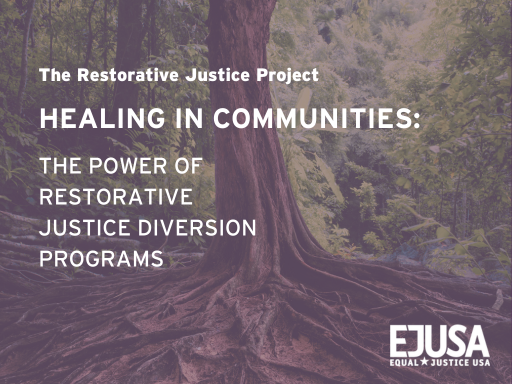
You may have heard the news last December about a new development at Equal Justice USA: the Restorative Justice Project.
Our Restorative Justice Project is a groundbreaking endeavor aimed at fostering healing and accountability within communities across the nation. At EJUSA, we firmly believe that restorative justice offers an impactful approach to building communities and ensuring their safety.
Through this project, our dedicated team is working closely with communities from California to Philadelphia, and from Nashville to New Orleans, and beyond, to develop restorative justice diversion programs. These programs are designed to address harm, meet needs, and identify root causes, while also providing a platform for meaningful accountability and transformation.
To give you a glimpse into the incredible work being done as part of our Restorative Justice Project, I encourage you to watch “Healing in Community: The Power of Restorative Justice Diversion Trailer.” This video showcases the perspectives and experiences of several restorative justice diversion programs within EJUSA’s National Restorative Justice Diversion Collaborative.
In these programs, participants are invited to deeply explore a set of questions that look very different from the questions asked by the criminal legal system. Instead of focusing on what law was broken and how we punish the person that broke it, restorative justice recognizes that what is elevated as a crime is not always an accurate reflection of the harm caused or a directive on what is needed to make things right. Restorative justice starts with the questions:
- What happened?
- Who was harmed and what do they need?
- Whose obligation is it to repair the harm and meet those needs?
Furthermore, these programs address unmet needs that may have led someone to cause harm. By asking questions like “Who else has been impacted by this harm? What are the root causes? and What is needed to address those root causes and prevent further harm?” We delve into the restorative justice process, aiming not only to repair harm but also to sow transformative seeds that lead to deeper relationships and meaningful accountability.
We distinguish between crime and harm. While crime is a violation of the law, harm is described and defined by those involved. For restorative justice, this distinction is understood deeply, and for survivors of harm, the category of crime determined by law enforcement rarely describes the harm they experienced and what impacted them most. Furthermore, as crime categories are often linked with corresponding punishments as dictated by the criminal legal system, the distinction between crime and harm is another example of returning power back to folks most impacted to describe what happened and determine what is needed to make things as right as possible.
Our Restorative Justice Project is honored to partner with communities across the country to answer the fundamental question: What do we do when harm happens? Through our work to develop innovative programs and partnerships, we’re providing communities with the tools and resources they need to navigate conflicts and harm in a way that fosters healing, growth, and connection — a pathway to real safety.
Thank you for your continued support of our work and please check out the work of our amazing partners.
We also want to express our gratitude to our funders, Just Impact and Galaxy Gives, for believing in our restorative justice diversion work over the years and for providing us with the flexible funding that made this video possible.



